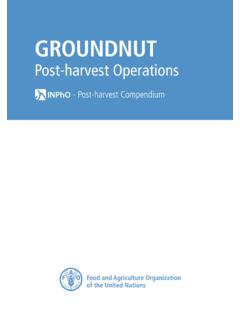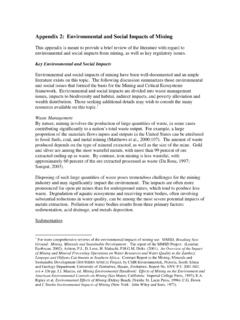Transcription of Gypsum as an Agricultural Amendment: General Use Guidelines
1 Bulletin 945 AuthorsLiming Chen Research Associate School of Environment and Natural Resources The Ohio State UniversityWarren A. Dick Professor School of Environment and Natural Resources The Ohio State UniversityDisclaimerThis guide was funded in part by the Environmental Protection Agency ( EPA) under a Resource Conservation Challenge grant. The contents of this guide do not necessarily reflect the views or policies of the EPA. The mention of trade names, individual companies, commercial products, or inclusion of web links to sites describing such materials or services is provided for information exchange and educational purposes only. Such mention does not constitute an endorsement, recommendation for use, or any form of implied 2011, The Ohio State UniversityOhio State University Extension embraces human diversity and is committed to ensuring that all research and related educational programs are available to clientele on a nondiscriminatory basis without regard to race, color, religion, sex, age, national origin, sexual orientation, gender identity or expression, disability, or veteran status.
2 This statement is in accordance with United States Civil Rights Laws and the L. Smith, , Associate Vice President for Agricultural Administration and Director, Ohio State University ExtensionTDD No. 800-589-8292 (Ohio only) or 1: Sources and Properties of 2: Properties of Gypsum That Provide Benefits for Agricultural uses ..8 Chapter 3: Agricultural and Land Application uses of 4: Gypsum 5: Economic Considerations Related to Gypsum Use ..24 Chapter 6: Analytical and Technical 7: Gypsum Handling and of Figures ..33 List of Tables ..34 Abbreviations and Basic Conversion Factors ..34 Element Factors for SI and Non-SI as an Agricultural Amendment: General Use Guidelines 34 Gypsum as an Agricultural Amendment: General Use GuidelinesPrefaceGypsum is one of the earliest forms of fertilizer used in the United States.
3 It has been applied to Agricultural soils for more than 250 years. Gypsum is a moderately soluble source of the essential plant nutrients, calcium and sulfur, and can improve overall plant growth. Gypsum amendments can also improve the physical and chemical properties of soils, thus reducing erosion losses of soils and nutrient concentrations (especially phosphorus) in surface water runoff. Gypsum is the most commonly used amendment for sodic soil recla-mation and can be included as a component in synthetic soils used in nursery, greenhouse, and land-scape applications. These multiple uses of Gypsum represent potential benefits to Agricultural and horti-cultural , a large amount of flue gas desulfurization (FGD) Gypsum is produced by removal of sulfur dioxide (SO ) from flue gas streams when energy sources, generally coal, containing high concentrations of sulfur (S) are burned.
4 Initially, most of the FGD Gypsum produced in the United States was used in the wallboard industry and only a small amount was used in agriculture. However, FGD Gypsum is suitable for Agricultural uses and, similar to mined Gypsum , can enhance crop production. As with other fertilizers and Agricultural amendments, FGD Gypsum must be used appropriately to avoid potential negative impacts on both Agricultural production and the environment. In many respects, there are similarities between the agri-cultural use of FGD Gypsum and nitrogen fertilizers in that both can provide crop production benefits but, if improperly used, can also lead to negative environ-mental sustainable society cannot continue to extract resources to create products and/or by-products that are then subsequently disposed of in landfills.
5 It is imperative that recycling of all kinds of materials is encouraged and becomes more common. Agricultural applications represent important new beneficial uses for FGD Gypsum . It can augment or replace commer-cial mined Gypsum , thus avoiding both energy-inten-sive and water-intensive mining activities associated with Gypsum extraction . Currently there is a lack of published Guidelines that provide General best management practices related to land application uses of Gypsum , including FGD Gypsum . To overcome this lack of information, Region 5 of the Environmental Protection Agency and The Ohio State University provided support to the authors to prepare this management guide titled Gypsum as an Agricultural Amendment: General Use Guidelines . An abundance of practical information related to Agricultural and land application uses of FGD Gypsum is included in the pages that follow.
6 This guide is also available online at The purpose of this management guide is to provide General information about Gypsum , especially FGD Gypsum , as a soil amendment in Ohio as well as other places where FGD Gypsum is available as a resource. This information will be useful for crop producers, soil and crop consultants, horticulturists, environmental consultants, environmental regulatory agents, and FGD Gypsum producers and as an Agricultural Amendment: General Use Guidelines 5 Gypsum is a soluble source of the essential plant nutri-ents, calcium and sulfur, and can improve overall plant growth. Gypsum amendments can also improve the physical properties of some soils (especially heavy clay soils). Such amendments promote soil aggregation and thus can (1) help prevent dispersion of soil parti-cles, (2) reduce surface crust formation, (3) promote seedling emergence, and (4) increase water infiltration rates and movement through the soil profile.
7 It can also reduce erosion losses of soils and nutrients and reduce concentrations of soluble phosphorus in surface water runoff. Chemical properties improved by appli-cation of Gypsum include the mitigation of subsoil acidity and aluminum toxicity. This enhances deep rooting and the ability of plants to take up adequate supplies of water and nutrients during drought periods. Gypsum is the most commonly used amend-ment for sodic soil reclamation and can also be included as a component in synthetic soils for nursery, greenhouse, and landscape use. These multiple uses of FGD Gypsum represent a great potential to provide benefits to Agricultural and horticultural users. Several possible sources of Gypsum for Agricultural use are currently available in the United States. These include mined Gypsum from geologic deposits, phos-phogypsum from wet-acid production of phosphoric acid from rock phosphate, recycled casting Gypsum from various manufacturing processes, recycled wall-board Gypsum , and flue gas desulfurization (FGD) Gypsum from power plants.
8 FGD Gypsum represents a new and large volume source and is produced when coal is burned to produce electricity, heat, or other forms of energy (Figure 1-1). Figure 1-1. Flue gas desulfurization (FGD) product is created by a scrubber that removes sulfur dioxide (SO ) from the flue gas stream when energy sources containing high concentra-tions of sulfur are burned. (Norton and Rhoton, 2007.)Combustion of coal produces 52% of our national need for electricity. During combustion, fly ash and bottom ash are produced (Figure 1-2). If the coal contains appreciable amounts of sulfur, sulfur dioxide is also produced, and the Clean Air Act Amendments of 1990 restrict sulfur dioxide emissions into the atmosphere from coal-fired facilities. This has spurred the develop-ment of flue gas desulfurization (FGD) systems that scrub the sulfur dioxide out of the flue gases and successfully bring utilities into regulatory compliance.
9 These FGD systems can generate large quantities of products, including Gypsum (Figure 1-2), which must be placed in landfills, deposited in surface impound-ments, or beneficially 1-2. Increase of total coal combustion products (CCPs) including fly ash (FA), bottom ash (BA), boiler slag (BS), and flue gas desulfurization (FGD) materials from 1966 to 2006. (American Coal Ash Association, 2010.) Flue gas desulfurization (FGD) Gypsum is created in limestone-forced oxidation scrubbers that remove sulfur dioxide from the flue gas stream after coal combustion. In General , a wet scrubbing process first exposes the flue gases to a slurry of hydrated lime. Capture of SO by the lime slurry initially forms calcium sulfite (CaSO O). Forcing additional air into the system oxidizes the calcium sulfite and converts it into Gypsum , , CaSO 2H O (Figure 1-3).
10 During and after the oxidation process, washing of the by-product can remove some water-soluble elements such as boron (B). Also, in some cases, removal of fines can decrease mercury (Hg) concentrations. The final step of the process involves partial removal of water by a combination of centrifugation and vacuum filtration. The Gypsum that is recovered is high quality and suit-able for industrial ( , wallboard) and Agricultural uses . Sources and Properties of Gypsum6 Gypsum as an Agricultural Amendment: General Use GuidelinesFigure 1-3. Schematic of the scrubbing process to produce FGD Gypsum . (Dontsova et al., 2 0 05.)Production of FGD Gypsum has gradually increased over the past several years (Table 1-1). In 2008, approx-imately 18 million tons of FGD Gypsum were produced of which 60% ( million tons) was used mainly in wallboard.








